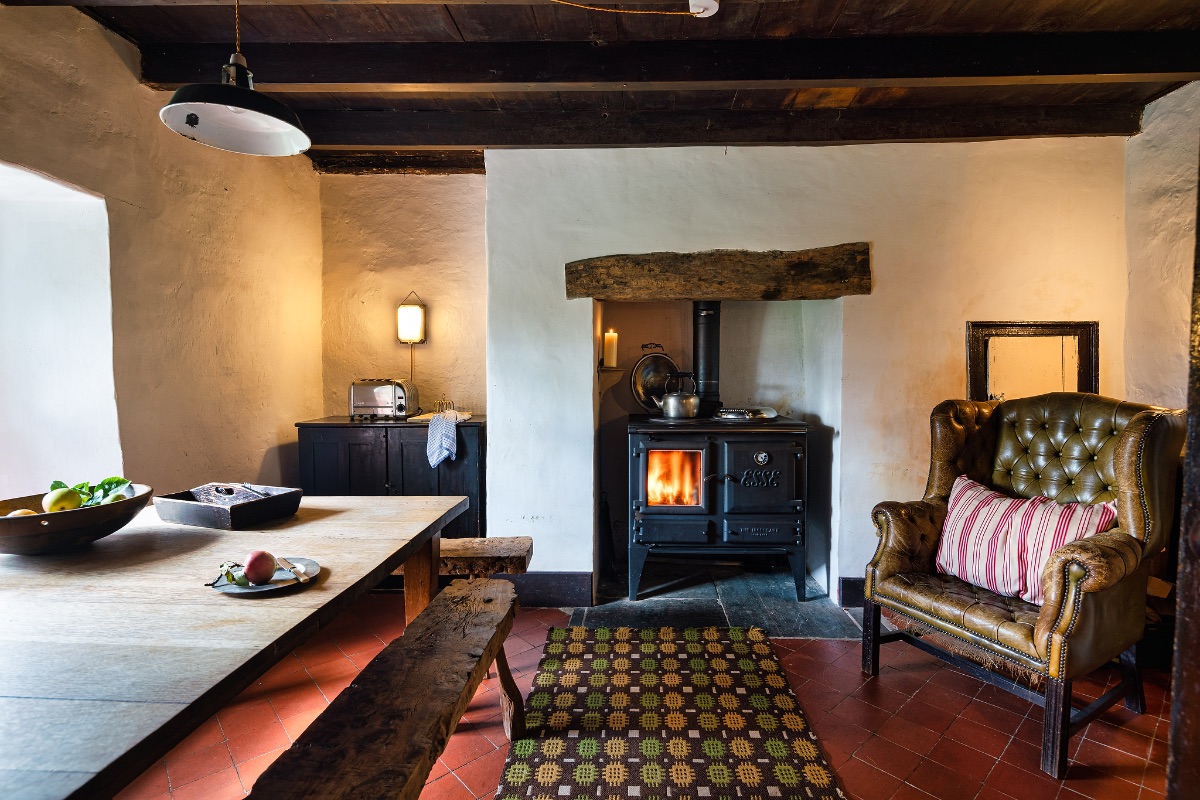Fireside stories from Under the Thatch.
Hafod
Unchanged since 1805, the immense open inglenook is exactly what you’d hope for, and expect in an Eryri / Snowdonia mountain farmhouse. These huge fireplaces take large logs and were the main original cooking space for the house. The size has the advantage that you can pull in even longish logs and feed them into the fire, saving on cutting and chopping. It makes the house, and works and draws a treat! BOOK HERE
Dyffryn
Dyffryn has a wonderful collection of fireplaces, as you’d expect in a substantial farmhouse in West Wales, but the newest addition is one of the loveliest – the Esse wood-burning range in the service wing. Esse have cleverly updated the classic cast iron cooking range with a glazed door on the firebox, so you have the best of both worlds – seeing the flames and an effective oven and hotplate to boil your kettle. The modern seals on the door mean that it’s so much more effective than its C19 antecedents. BOOK HERE
Bryn Eglur
Bryn Eglur enjoys an original late Victorian cast iron simple cottage range that owner Dorian salvaged, restored and installed. Above is a simple West Wales chimney hood, that he also restored, and when you walk in today, apart from the Ercol seating, you feel like you’re stepping back to the days when the cottage was built in the C18. If you prefer a more modern range for cooking there’s a beautiful deep-red Rayburn in the modern kitchen. BOOK HERE
Land Girls’ House
Built for the Land Girls working on Somerset farms in WWII, the original enamelled 1940s range here is a delight – if you’ve ever used one of these you’ll know just how effective they are at heating the room as well as the ovens. Up close you can feel the lovely thick speckled enamel on the cast iron front – much thicker than on say modern Agas or Rayburns. Alas, these ranges are often lost in modern conversions – but here owners Michael and Mary have really gone to town to restore and retain all the original WWII details. BOOK HERE
Suffolk House
Beautiful Suffolk House has architectural features from at least the last three centuries, being a timber-frame house that was later ‘Georgianised’ and a rich palimpsest of growth and changes over the years. The parlour is our favourite room in its rich red and with a formality that you’d expect in such a ‘withdrawing’ room, quality antiques and artworks, mostly from the C19. The fireplace is an early cast iron insert into a later mantle, but does the trick and sets the tone for the richest of the rooms in this relaxed small country house. BOOK HERE
Cwm Hill
Cwm Hill was abandoned in the 1940s and empty until we restored it – hence nobody had really messed around with the original fireplace. We had to re-weave the Pembrokeshire chimney hood, but what is interesting here (and perhaps illogical, though we’ve seen it many times) is that the fireplace and ‘dairy’ were adjacent against the fireplace wall. A spine of stone separates them. We converted the former dairy to the right into a small shower room so as not to extend this house which remains in its original form since built in C1850. BOOK HERE
Bryncyn
Bryncyn was another rescue by Dorian, but rather than taking it back to its C19 roots, he went modern this time and installed a simple modern firebox on a piece of local slate. The original features are still there, but the house is dressed in white, almost minimalist, and with sofas that he made himself. We’re very jealous of his incredible skills! BOOK HERE
Trehilyn Uchaf
When it came to renovating Trehilyn farmhouse there were a variety of fireplaces from different periods to consider, but we’re delighted that owners Jo and Griff Rhys Jones kept the simple tiled bedroom fireplace in the main bedroom – as this is the kind of fireplace most lost in the renovations and ‘restorations’ of the last 40 years. These cast/concrete and tiled fireplaces started to appear in the 1930s, and with their pre-formed firebacks they were very effective at heating bedrooms before central heating, and houses across Britain swapped their Victorian cast iron ones to these clean, modern tiled fires that remained popular into the 1960s. Most likely date to the 1940s or early 1950s. There’s a tendency for people to throw these out and replace them with Victorian replicas, which is a great shame, as the C20 is definitely a part of the history of these farms. BOOK HERE
Ysgubor Gwyrdd
Barns don’t have fireplaces as such, and neither did Ysgubor Gwyrdd high on the hill above Machynlleth – hence a free licence to install a large modern woodburner that can really do the job of heating the huge open space. Great styling by Dafydd and Preds, and massive insulation mean that this off-grid home is warm at any time of the year. BOOK HERE
‘Teach Mhicí’ – Mickey’s Cottage
When we renovated Mickey’s Cottage at the beach in Donegal the house was in poor condition and a very rusty cooking stove sat in front of what we assumed was a wall that had lost its fireplace. When we removed what transpired to be a late C20 concrete block wall we found the original 1860s Donegal hearth behind, which we then lime-pointed up and used as the backdrop for the modern turf/ wood burner. These Donegal hearths are remarkably shallow and high, yet they are carefully designed and drawn so well. BOOK HERE











